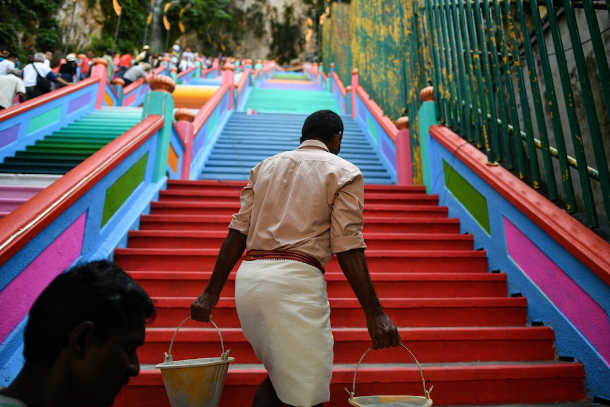
A worker walks up the newly-painted 272-steps staircase leading to Malaysia's Batu Caves temple in Kuala Lumpur on Aug. 30. A dispute over another Hindu temple nearby on Nov. 26-27 has inflamed religious and racial tensions in the country. (Photo by Manan Vatsyayana/AFP)
A violent dispute over a temple in Malaysia boiled over this week, causing religious and racial tensions to spike around the country and setting the scene for new rules concerning the construction of places of worship.
Prime Minister Mahathir Mohamad said on Nov. 28 that the government needs to regulate the building and location of all new religious structures to prevent civil disorder, after a melee broke out in Kuala Lumpur from Nov. 26-27.
Mahathir was speaking after hundreds of Hindus gathered to try and save the Sri Maha Mariamman Temple in Subang Jaya, on the edge of the capital, which has been scheduled for demolition by the company that owns the land it sits on.
He said it appeared that some of those who had taken part in the rally were not ordinary protesters but were literally out for blood.
"We cannot allow this. Although we want to be liberal and allow demonstrations, trying to kill someone is not a demonstration, it is attempted murder," he warned.
Things began spiraling out of control on Nov. 26, the day the temple was due to be relocated following an agreement that included the exchange of 1.5 million ringgit ($362,000) in compensation to the temple management committee.
Despite the agreement, bitterness over the relocation lingered on. The origin of the temple is now in dispute due a lack of official records pertaining to its history. Some claim it is over a century old while others say it was erected in 1974.
When a group of Malays, some armed with machetes, marched into the temple and confronted devotees to hasten their departure, a fight broke out that escalated into a riot. In the process, vehicles were set on fire and temple property damaged.
Police arrived later and calm was restored but tensions remained high.
Thousands more turned up near the temple in a show of support in the early hours of Nov. 27. A second round of rioting then erupted. Fire and Rescue Department personnel were called in to douse the burning vehicles but they too came under attack, leaving one man fighting for his life.
With tensions running high, Malaysians took to social media to allocate blame.
Shortly afterward, reports of a mosque in the southern state of Melaka being desecrated surfaced. A spiral of threats and counter-threats were issued.
It was enough to alarm and unite politicians on both sides of the divide. They called for calm and urged the police to quickly issue a warning.
Home Minister Muhyiddin Yassin subsequently disclosed what the authorities believe triggered the unrest.
He said preliminary police investigations of 21 people who were arrested revealed links between lawyers hired by the company and a group of Malays and foreigners to forcibly occupy the temple and hasten the handover.
"They did not think it through when they asked Malays to take charge of the Hindu temple," Mahathir told reporters after visiting the fireman who was critically injured.
He said employing foreigners in the situation was not helpful, as they did not understand Malaysia or its problems.
The temple in Subang Jaya once sat in the middle of what was formerly a rubber plantation called the Seafield Estate. It started out as a relatively humble structure but became more elaborate over the years.
Once surrounded by rubber trees, it is now hemmed in by a concrete jungle. Meanwhile, the land it sits on is worth millions of ringgit.
Plans to relocate the temple have been fielded since 2007, after the land was purchased by One City Development Sdn Bhd, which is owned by a Philippines-based conglomerate, Ayala Corp.
The court settlement between the landowners and the temple management committee obtained in 2014 included a plot of land, 3km from its present location, for a new temple along with the sum of 1.5 million ringgit.
Mahathir stressed during a press conference on Nov. 28 that the landowners had the final say as it was their property.
"The problem is that temples are being built anywhere, even on other people's land. That is a problem that we are seeing today. Many temples are built on land that does not belong to the temple owner," he said.
"So now the government will pass a resolution and make it a condition that houses of worship, like mosques or temples or churches, cannot be built without the permission of the local authority.
"They cannot build on land that doesn't belong to them. That will solve the problem."
Mahathir noted, however, that this would only be a solution for new places of worship.
"I am talking about the future. Now, I think we cannot do anything," he said when asked if the new rule would affect existing places of worship.
The government views the court-recorded settlement between the two as binding even though they are free to pursue the matter in higher courts.
The government will not interfere in the matter, Mahathir said.


